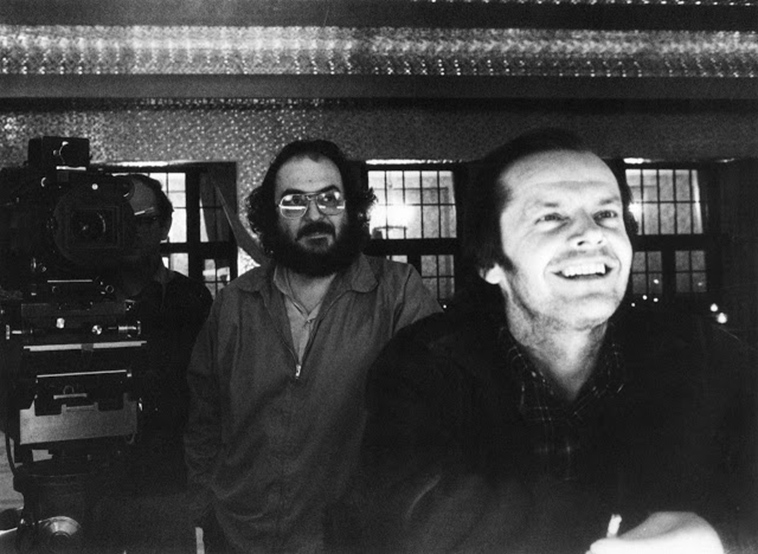“The Shining” that we all know and love is 1980 Stanley Kubrick film based on a Stephen King novel of the same name. The world remembers the movie mostly for its intense, door-busting scene with Jack Nicholson’s face screaming “Here’s Johnny!” while wielding an axe – and funnily enough, the prop department struggled to build a door strong enough for him to break. Being that he was once a volunteer firefighter, Nicholson had no difficulty destroying 60 prop doors over the span of three days.
Or maybe, audiences remember the film’s symmetrical shots of the creepy Grady twins in the hallway, or the frightening visual of Nicholson freezing to death, or the hotel elevator overflowing with a river of blood. But there’s more than meets the eye when it comes to this horror classic.
The backstory for the fruition of the nearly 40 year-old Kubrick classic begins with a large stack of scary stories. Kubrick ordered his assistants to buy piles and piles of horror novels for him to read in his office to hopefully develop into films. Kubrick would sit at his desk and flip through the first few pages of each and throw them against the wall if he disliked them. When his secretary noticed an unusual quietness, she walked inside his office to find Kubrick deeply engaged in the reading of Stephen King’s 1977 novel The Shining.
Somehow word made itself back to King and he formulated a script for how he envisioned his novel to play out on the big screen. Kubrick, the stubborn perfectionist he became to be, refused to read the screenplay he had developed and had minimal contact with the author. Kubrick would call King in the middle of the night not for advice on how to adapt his vision, but rather, to ask him “Do you believe in god?”
King felt his vision was being rejected and became increasingly disinterested in Kubrick’s rendition of his book. To his defense, The Shining was a vaguely autobiographical story of how alcoholism can ruin one’s life. The novel came after King’s own stint with a crippling alcohol reliance and addiction, so it can be understood why he grew infuriated by how his personal story was misconstrued and portrayed by Kubrick. Now, paranormal elements and murder aside, it’s easy to see how King could be offended that his personal writings were appropriated for a gory blockbuster hit.
Yet, King wasn’t the only one shafted by Kubrick’s directorial decision making. While Kubrick got along swimmingly with leading (crazy) man Jack Nicholson, his relationship with leading lady Shelley Duvall was a tattered, terrible one. In an alternative take on method acting, Kubrick seemed to be “method directing” Duvall into playing a terribly distressed, scared wife by isolating her from the rest of the cast and crew and by constantly insulting her performance. Kubrick was brutal on Duvall in an attempt to bring out her best acting chops, but the notoriously mean behavior made filming hellish.
“From May until October I was really in and out of ill health because the stress of the role was so great. Stanley [Kubrick] pushed me and prodded me further than I’ve ever been pushed before. It’s the most difficult role I’ve ever had to play,” said Duvall who suffered from nervous exhaustion during excruciatingly long filming days. The environment’s stressful circumstances caused Duvall to lose her hair and cry to the point of dehydration.
After one incident on set when Duvall fainted from exhaustion in the hallway following the filming of one scene, Kubrick turned to her and said, “I don’t sympathize with you Shelley, it doesn’t help you.”
Kubrick’s wicked mind games even landed him in the Guinness Book of Records for most retakes of one scene with dialogue. The scene in question was Duvall swinging her baseball bat at Nicholson on the staircase, and reportedly had to be shot 127 times to satisfy Kubrick. Although, Kubrick’s neuroses should come as no shock, as he made Tom Cruise walk through one door frame 95 times consecutively for “Eyes Wide Shut.” Can we credit Kubrick for instilling character development in Duvall through his methodical directing, or can we blame the horrifying sights she had to see on set for making her acting believable?
Kubrick was similarly hard on the 70 year-old cook in the film, played by actor Scatman Crothers. For one simple shot of a slow zoom-in to Crothers face, Kubrick demanded 60 takes, causing him to break down in tears. Kubrick justified his obsessive retakes process to Rolling Stone magazine in 1987, “It happens when actors are unprepared. So you shoot it and shoot it and hope you can get something out in pieces.” Kubrick also got Nicholson into character by strictly feeding him only cheese sandwiches for two weeks – which he hates.
“The Shining” filmed chronologically for 250 days with a small crew of ten people or less at both a soundstage constructed in England (based on Yosemite National Park’s hotel Ahwahnee Lodge) as well as exterior shots of the Timberline Lodge in Oregon. A linear filming schedule like Kubrick conducted meant every set and actor had to be ready to roll at the drop of a hat because he was filming in the order that the filming audience would see it. He also took liberties of the source material by swapping the integral Room 217 for the nonexistent Room 237 in order to appease Timberline Lodge’s management over concerns of how it could hurt business.
Amongst other ingenious tricks up Kubrick’s sleeves was how he managed to make the snow in the final hedge maze scene out of Styrofoam and 900 tons of salt, as well as how he kept young actor Danny Lloyd (Danny) in the dark about how “The Shining” was a horror film, not a family drama. Lloyd was six years-old at the time of filming, and “The Shining” marks his first and last soiree into acting.
Once Kubrick’s vision for “The Shining” was completed, it was released as a 146-minute masterpiece. However, this version is not the version we know and love, as tacked onto the tail end is an alternative ending set in a hospital where Wendy and Danny are recuperating. Wendy is subsequently told that the police was unable to find her husband’s body on the hotel’s property, further perpetuating the theory that Nicholson’s character was a ghost the whole time. Kubrick scrapped this two minute scene a week after its release in order to make the movie ending more ambiguous and it has yet to surface publicly.
“The Shining” has withstood the test of time as a gripping descent into madness, through the stellar acting of Nicholson and the stunning visual cues executed under Kubrick’s keen eye. As it nears its 40th anniversary in 2020, one can only hope even more secrets are uncovered about this cinematic staple.
Watch Kubrick’s 17 year-old daughter Vivian’s exclusive behind the scenes footage below.







